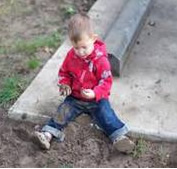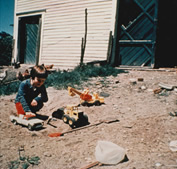Possible Sources of Lead
Soil
Lead in soil is a lesser-known but equally critical cause of lead poisoning in children.


Here in the Bay Area, many of our homes are surrounded by yards that have lead contaminated soil. This is especially a concern if the soil is bare, children play in the dirt, people or pets track dirt inside, or sometimes when we eat from a garden.
How Lead Gets in the Soil
Lead has made its way into the soil around our homes through three routes: paint, leaded gasoline and environmental emissions. Deteriorating exterior lead-based paint can fall off of a house if the paint is chipping or peeling, or from friction surfaces such as windows. If exterior painting prep work is done improperly such as by dry scraping, sanding or water blasting, lead-based paint can fall into the soil. That's why using lead-safe painting practices and proper containment methods are vital. Old homes which had their exteriors scraped and painted years ago, often have high levels of lead in the soil around the perimeter of the home.
Some lead in soil comes from the period before lead in gasoline was banned. During this period, lead came out of cars in the exhaust and would settle into the soil close to highways and major cross streets.
Homes located in industrial areas sometimes have lead in the soil from industrial emissions.
Lead that has been deposited into the soil from these sources, anywhere from a day to 50 years ago or more, may still be in your soil.
Alameda County Soil
Alameda County has varying amounts of lead in it's soil from extremely high to low. Some areas have one or all of the conditions that commonly contribute to soil being lead contaminated; neighborhoods with very old housing, mixed residential and industrial areas, and freeways.
In a survey of 292 soil samples collected from yards with bare soil in Alameda County between 2009 through 2011, 97% were determined to contain over 80 ppm, the level at which the CalEPA Office of Environmental Health Hazard Assessment has determined could raise a child's blood lead level. Over 60% of the bare soil samples contained more than 400 pm of lead, which Federal agencies consider a lead hazard in play areas. And over 21% of the samples had over 1,000 ppm of lead, the level defined by the State as hazardous waste.
How Children are at Risk
Children love to play outside, and many like to play in the dirt. When kids play in the dirt, they inevitably get their hands and toys dirty. If hands or toys with lead-contaminated soil on them make their way into a child's mouth, then the child can be exposed to lead. This can easily happen through normal hand to mouth behavior. It's important to wash children's hands frequently, especially before eating. Toys should also be washed periodically.
Children may also be exposed to lead if contaminated soil is tracked into the home on shoes or pets. Covering bare soil makes a big difference.
How to Find Out if Your Soil has Lead
Soil can be tested by sending a sample to a laboratory or by hiring a certified professional. According to Federal and State agencies, lead levels that are equal to or above 400 ppm in bare soil are considered a lead hazard in play areas. In California lead levels that are equal to or above 1000 ppm in soil are considered to be hazardous waste. For more information visit our page on How to Test for Lead.
Instead of testing, another option is to assume your soil has lead, especially if it is next to an older building, busy roadway or in an industrial area.
What to Do
If your soil has lead or if you're just not sure, the most common approach is to create a barrier between the soil and your child. There are a number of ways to create these kinds of barriers. If you cover bare soil with landscaping, it will help to prevent people from being exposed to lead. This can be accomplished by planting sod in lawn areas, and placing ground cover or mulch in bed areas.
Whenever loose material like sand or wood chips is put down over contaminated soil in a traffic or play area, a weed-block fabric should be placed under it and at least six inches of the covering material placed. Watering and maintenance are crucial to keeping your garden lead safe.
Shrubs can be used as a barrier; for example, a row of junipers along the house tends to keep kids from playing in the high risk area next to the house. A fence can do the same thing. It is a good idea to create a safe play area like a sand box, to give kids an alternative place to play, away from contaminated soil.
Also be aware of structures in the yard that may be a lead hazard, such as an old garage with peeling paint. For more information visit our page on reducing lead hazards in paint and soil.
See tips on lead-safe urban gardening.
 Community Development Agency
Community Development Agency ABOUT US
ABOUT US